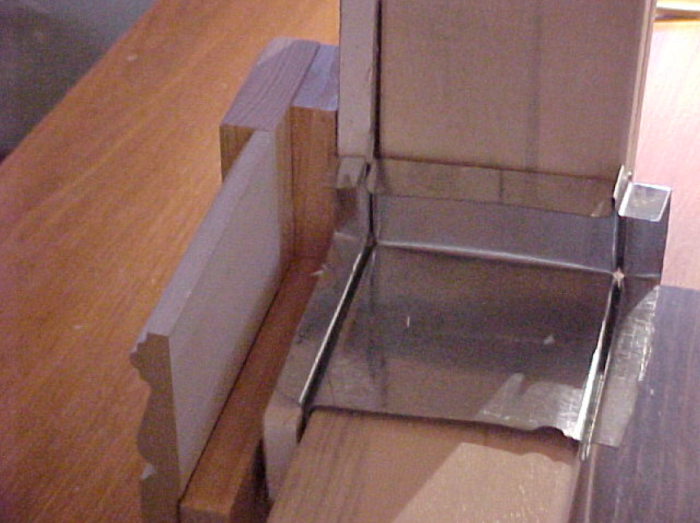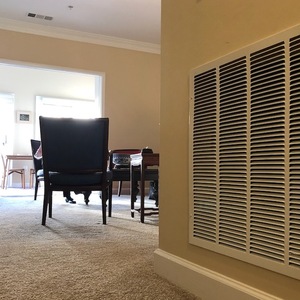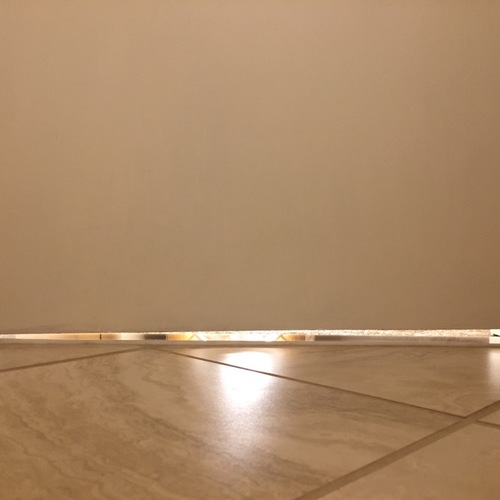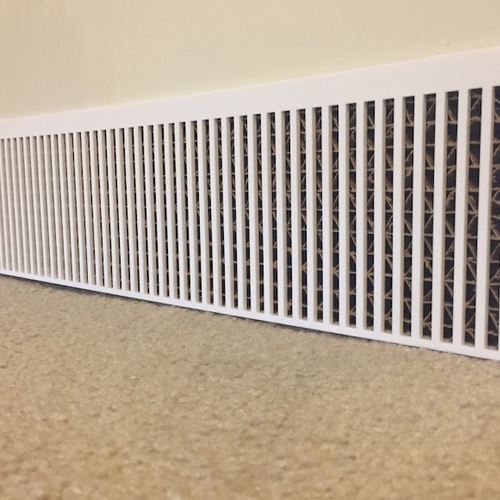Image Credit: Rob de Keiffer - Boulder Design Alliance
Image Credit: Rob de Keiffer - Boulder Design Alliance This drawing shows high-low transfer grilles; it's from the GBA Construction Detail library: 7-00001
Image Credit: Steve Baczek This drawing shows above door transfer grilles; it's from the GBA Construction Detail library: 7-00003
Image Credit: Steve Baczek This drawing shows a jump duct; it's from the GBA Construction Detail library: 7-00005
Image Credit: Steve Baczek
If a forced-air HVAC system is pushing more air into a space or room than return pathways can match, some spaces in the home become pressurized and others depressurized. This imbalance can cause problems: thermal comfort, moisture, and even combustion safety.
Types of HVAC returns
In an ideal world, every supply would have a companion return duct. This approach is called a dedicated return for each supply. But most older and even many new homes have one or maybe two central returns located in common spaces because it is less expensive and difficult to locate and run just a supply to each space. With central returns, here are the ways to provide return pathways: door undercuts, jump ducts, transfer grilles, and the deKeiffer bypass.
Door undercuts
This is certainly the easiest and cheapest way to attempt a return pathway but it is rarely sufficient. For most situations, door undercuts need to be greater than 1.5 inches to be sufficient and that amount of undercut is very often not acceptable for aesthetic or privacy reasons.
Jump ducts
A jump duct is a large insulated flex duct that connects two ceiling grilles, one just inside the door to the supplied room and the other just on the other side of the door in the hallway ceiling. The sharp bend and variegated surface of the interior lining of the jump duct reduces sound transfer without compromising air movement. Since this approach penetrates the ceiling plane, the jump duct must be carefully air sealed if it breaks into an unconditioned space like the attic.
Transfer grilles
There are two types of transfer grilles, above-door and high-low offset. The above-door transfer grille simply has two grilles located above the door between the room and common space, one on each wall, with offset baffles to limit sound transmission.
The high-low offset is located in an interior wall framing cavity adjacent to the door between the room and common space. One grille is located high on the wall on one side (usually the common space), the other low on the wall (in the room). The offset reduces sound transmission. Note that this interior framing cavity must be clean and without wiring penetrations (or seal these penetrations as you would if it were an exterior wall framing cavity).
The de Keiffer bypass
An HVAC engineer from Boulder, CO, Rob deKeiffer of the Boulder Design Alliance, came up with an elegant return pathway: the deKeiffer Bypass. The door trim is spaced off of the wall on both sides enough to create around 23 square inches of free air space connecting the room and the common space. The framing cavity space above the door is sleeved with sheet metal to create a dedicated pathway connecting the two sides of the spaced-out door trim.
Armand Magnelli’s (Livable Housing, Inc.) perspective
Another approach is to install a product that combines a metal sleeve with an interior baffle and grilles on both sides of the wall, such as the Tamarak Return Air Pathway (RAP). Or one of Halton’s transfer grilles (these more commercial in nature). These products purportedly provide better noise reduction with good air flow and are relatively easy to install. The fit between standard stud spacing in interior partition walls. For an independent analysis of several approaches see the following review by the Building America Program.
An advantage of using the products from Tamarak is that they are sized for CFM capacity, an important variable in balancing the airflow between rooms. The issue with the products from Tamarak and Halton is that while they provide an attractive and effective packaged solution it may be difficult to convince local HVAC distributors to stock their lines of products forcing contractors to order them online. Some of the other solutions are fabricated from stock components available at most HVAC distributors.
The use of any of these solutions may also improve performance of whole house ventilation systems by enabling better circulation of fresh air from bedrooms at night, a crucial time to deliver fresh air to occupants.
Your perspective
Be great to learn what method you use and why? Weigh in—it’s what GBA is all about.
Weekly Newsletter
Get building science and energy efficiency advice, plus special offers, in your inbox.
















15 Comments
A hybrid approach
We use a comination of a central return plus seperate returns. We do not necessarily have a dedicated return for each supply but we do put a return in each bedroom and then a larger central return or multiple depending on the size of the home and layout.
In order to meet some homeowner's budgets, we have eliminated seperate returns a few times trying to save them some money. Typically when we ask our HVAC guy to run jumper ducts, he says it is just as easy to run a few seperate returns if there is not a spralling layout so we rarely use jumper ducts. The last time we completely eliminated all bedroom returns/jumpers we cut a series of vertical slits in the baseboard in the common wall between the bedroom and hallway - looks like a nice custom wood grill rather than having metal registers on each side of the wall. Probably does not get the same amount of air flow but still a decent trade off for a low cost approach.
I do have one question in your paragraph on transfer grills when you say - "or seal these penetrations as you would if it were an exterior wall framing cavity" - I'm assuming you are referring to penetrations in the sole plate of top plate - why would you seal an interior wall differently than an exterior wall. Even interior walls are connected to crawl spaces, attics, etc. - we always seal all penetrations the same no matter where they are.
Hard to tell from the photograph - but I am assuming if you use the de Keiffer design you must use sruare stock for door casing to butt each other - no chance to mitre the corners since the header piece is in a different plane as the legs - am I seeing this correctly?
Good article - Thanks for the great summary of options.
Good article
Peter,
Thanks for your excellent article on an important topic.
For more on the problem and possible solutions, see "Return-Air Problems."
Response to Dan Kelly
Dan, when you say you typically run separate returns for bedrooms, do you mean ducted all the way back to the main return trunk? Do your returns "pair" with the supply in the same run or space?
And your baseboard slits approach sounds really interesting---any chance you can attach a photo? I think GBA allows that now with posted comments.
On the sealing of penetrations with high-low transfer grilles: sealing any penetrations means a dedicated pathway in that one framing cavity. It's just to isolate that one cavity from all the others, mainly so that pathway remains clean.
And yes, you are correct on the de Keiffer bypass: the way it is depicted, the trim must involve that corner plinth block. I tried to contact Rob de Keiffer about this because my memory tells me that earlier versions of the bypass spaced ALL of the door trim off the walls so that all trim was co--planar. That would give more free air space because the small spaces between the door unit and the rough opening could then contribute. I can't think of why Rob may have adjusted this approach.
Martin's Return Air Problems blog
Darn, Martin. GBA has so much great stuff now that even the editors (at least one of them!) can be unaware of companion information. Fortunately, these two blogs support and complement each other pretty well. Yours is a great blog with more detailed information on pressure issues associated with return pathways. Thanks.
No problem
Peter,
I know, it's hard to keep up with the river of good information.
Anyway, I just added a "Related Content" box to your excellent blog.
Response to Peter
Yes - Peter - we will run a metal plenum out of the return side of the system and branch off each return with flex duct. Not sure what you mean by "pair" - but it is not connected to the supply in any way - all supplies are done the same way - a main metal trunk with flex branches.
I'll see if I can track down a photo of our baseboard slits. I think we are on the same page with the air sealing - must have misunderstood your original post.
the road block
The effectivness of these return air solutions are also contingient on the central return air being properly sizes to the equipment it is attacheded to, something in my testing I have found is rarely the case. Just listen and you will hear the problem too. Which leads to a design shift, properly sized equiment running for longer cycles at lower system air flow (but acctually mixing the rooms) will reduce some of the pressure imbalances with the way many of our systems short cycle so that we can rapidly change the temperature in any given room. Some times it seems like we fix one problem and make another, I have seen new homes in Las Vegas where jumper ducts were designed into each room, with massive poorly insulate duct (R8 with a summer time delta T of 70F) in unconditioned attic space, and the primary air barrier the ceiling sheet rock perferated by far to many large grills. We often run a dedicated ruturn to the master suite, remove delivery from small interior bathrooms when grills are not manufactured to deliver the small cfms required. While it is not the complete fix I think it should be mentioned when discussing room pressure imbalances, at least on the west coast it is one of the primary culprits.
Tamarak Thru-Door RAP
The president of Tamarak lives nearby and he asked me to lunch a couple months back. He brought along samples of their new "Perfect Balance" return air pathway - good idea and one that will appeal to some builders. It's a plastic louvered, internally baffeled hole you cut in the bottom of a door.
He ran through the specs which I'd boil down to a 2 Pa differential at 100 cfm supplied into a closed room. I think that's about the same pressure differential you'd get with a good jump duct and better than a de Keiffer bypass, door undercut or other methods.
The sound transmission is minimal since the bypass is low - about the same as an ordinary door undercut.
I plan to install them on the bathroom doors in my 4 rental houses - I'm sure the tenants will be pretty frank with their opinions.
They list at $29 with quantity discounts. That's very reasonable. And when you figure the materials and labor for alternatives I think this new system may have the edge.
Ideally the "Perfect Balance" will be stocked and installed by door shops making it even easier.
http://www.tamtech.com/userfiles/Perfect_balance_cut_sheet_oct_2010.pdf
http://www.tamtech.com/store/pressure-imbalance-relief-hvac-balanced-ashrae-energystar-stransfer-grille,Product.asp
transoms
The deKeiffer Bypass looks like an intriguing solution to correct pressure imbalance between rooms. Another more traditional and perhaps simpler approach is to build operable transoms above doors.
Transoms and Tamarack
Hi Mike and James -
Excellent additional info and perspective--thanks.
Mike - let us know how the Tamarack Perfect Balance approach works for you.
Peter
Return Air and Energy Efficiency
Great article on return air! I'm curious to know if anyone is aware of any data that quantifies the energy savings that can be achieved by adding return air?
Rerutn Air and Energy Efficiency
Hi Christopher -
I am not aware of any information or studies on this topic. Pressure balancing forced-air HVAC systems is mostly about thermal comfort, indoor air quality, and overall building durability. The energy impacts are more indirect and subtle: efficient operation of the blower, pulling in unconditioned air depending on where the duct runs are located.
Return Air and Efficiency
It stands to reason a balanced and unrestricted air flow for the HVAC supply and return would make the system more efficient. Heat would be delivered faster and would satisfy the thermostat more quickly.
The location of room supplies and returns should be opposite each other for good mixing of conditioned air. If the supply is in the floor, the return should be near the ceiling. In lower levels the supply is often located in the ceiling, floor level returns will help with even temperatures and recover cold air in the summer months when AC is used.
On my last building project, a 2nd story addition with a vaulted ceiling and open space above the walls, I went with 1 large centrally located return near the ceiling. The 6 supplies are located in the floor so the mixing of air in this space is even and thorough. The addition also has 120 sf of south facing glass so the central return pulls the sun warmed air back into the system to be redistributed through the house.
high/low grilles
In the first drawing above showing high/low grilles, the hallway and bedroom should be swapped because there is usually much more furniture in bedrooms than in halls, and you don't want furniture blocking the air flow.
Afordability and ballancing.
Great conversation. Housing rehabilitation projects in the affordable housing world are often confronted with HVAC systems that were poorly designed and/or patched together over time by a number of different mechanics. The lack of dedicated returns is common and running additional ductwork is cost prohibitive. I typically prefer the transfer grill options when creating a return air path for bedrooms because of their simplicity and because I try to avoid ceiling penetrations into unconditioned attic space. Jumper ducts are also too prone to abuse in attic space used for storage. I've seen the Tamarak RAP grills resolve imbalances caused by an inadequate return air path and they are simple to specify and install. I wish they were easier to find.
Log in or create an account to post a comment.
Sign up Log in